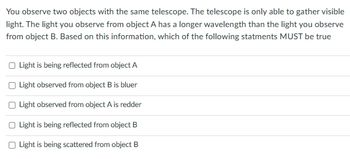Question

Transcribed Image Text:You observe two objects with the same telescope. The telescope is only able to gather visible
light. The light you observe from object A has a longer wavelength than the light you observe
from object B. Based on this information, which of the following statments MUST be true
Light is being reflected from object A
Light observed from object B is bluer
Light observed from object A is redder
Light is being reflected from object B
Light is being scattered from object B
Expert Solution
This question has been solved!
Explore an expertly crafted, step-by-step solution for a thorough understanding of key concepts.
Step by stepSolved in 3 steps with 4 images

Knowledge Booster
Similar questions
- Why are x-ray telescopes all in space, rather than on the Earth?arrow_forwardIf a telescope is 10 times bigger in diameter it will gather _________ times more light than a smaller telescopearrow_forwardCompare the light-gathering power of one of the 10-m Keck telescopes with that of a 0.5-m telescope.arrow_forward
- Astronauts observing from a space station need a telescope with a resolving power of 0.6 arc second at a wavelength of 530 nm and a magnifying power of 220. Design a telescope to meet their needs.What will its light-gathering power be, compared with a dark-adapted human eye? (Assume that the pupil of your eye can open to a diameter of about 0.8 cm in dark conditions.)(State the necessary primary diameter of the telescope, in m, and the ratio of the focal lengths below.)arrow_forwardYou can see your lecturer in class (if you are there) because They emit visible light They reflect visible light O They emit infrared radiation O They reflect infrared radiationarrow_forwardInstead of a dot, sometimes the telescope image of a star looks like concentric rings. This is due to: a)diffraction. b)reflection. c)refraction. d)scatter.arrow_forward
- The image shows the spectra of two objects, labeled 1 and 2. Which of the following statements is a correct interpretation of these spectra? Intensity 1 2 Wavelength O object 1 is younger than object 2 object 1 is brighter than object 2 at all wavelengths object 2 is farther from us than object 1 object 1 emits less red light than object 2 object 2 emits more blue light than object 1arrow_forwardWhat is the limit of angular resolution for a 6.3-m telescope at a wavelength of 533nm?arrow_forward
arrow_back_ios
arrow_forward_ios